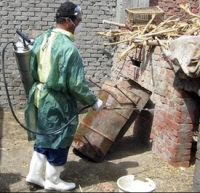



Today Most Countries Overcome Avian Influenza Outbreaks When They Occur
WORLD - 59 countries have reported outbreaks of the H5N1 strain of avian influenza from 2003 to date. The Veterinary Services (VS) in the majority of these countries have successfully dealt with these outbreaks.The disease remains endemic in at least three countries ( Indonesia , Nigeria and Egypt ) and continues to appear in previously unaffected countries. These events offer valuable opportunity to further identify the complex issues in dealing with the disease.
Stronger veterinary governance and solidarity worldwide: a strategy as valid as ever

The OIE continually strives to align strong and credible Veterinary Services (VS) with international standards in terms of governance, organization and establish necessary scientific, diagnostic expertise and capacity in all OIE member countries . This will be the key in the continued success of dealing with highly pathogenic avian influenza (HPAI), as well as any other emerging and re-emerging disease in the future.
The Veterinary Services (VS) are the very core of the system for the prevention and control of HPAI and play a major role in every country as guarantors of animal health and in associated public health issues. A single failing country and the whole world is at risk of infection. Solidarity is a critical component of the fight against avian influenza. This is why the OIE uses the “Performance, Vision and Strategy” tool to identify the needs for investment in developing countries which is key for the prevention and eradication of avian influenza worldwide.
With the focus of the international community on the current global HPAI disease situation, the OIE's objectives of promoting transparency in collecting, analysing and disseminating veterinary information, strengthening international coordination and cooperation in the control of animal diseases and zoonoses continue as a priority of the organisation.
Science and peer-reviewed guidelines as a foundation
The science-based standards, guidelines and recommendations issued by the OIE thanks to its worldwide network of scientists are designated as the international reference in dealing with HPAI. The OIE continues to develop and revise those standards and to address scientific and technical issues of prevention, control and eradication.OIE reaffirms the most effective strategy for dealing directly with HPAI in poultry; early detection and early warning, rapid confirmation of suspects, rapid and transparent notification, rapid response (including containment, management of poultry movement, humane stamping out and vaccination where appropriate).
The long term vision of this strategy that OIE shares with FAO is to minimize the global threat of HPAI in domestic poultry and human infections through progressive control and eradication the disease in poultry. Achieving this goal will stabilize poultry production and food security globally, enhance market access and trade in poultry and poultry products; improve public health including food safety, improve the livelihoods of rural populations and diminish the global threat of a human pandemic .








